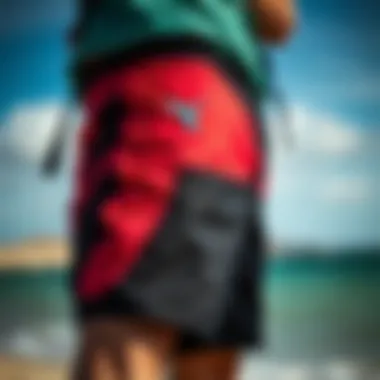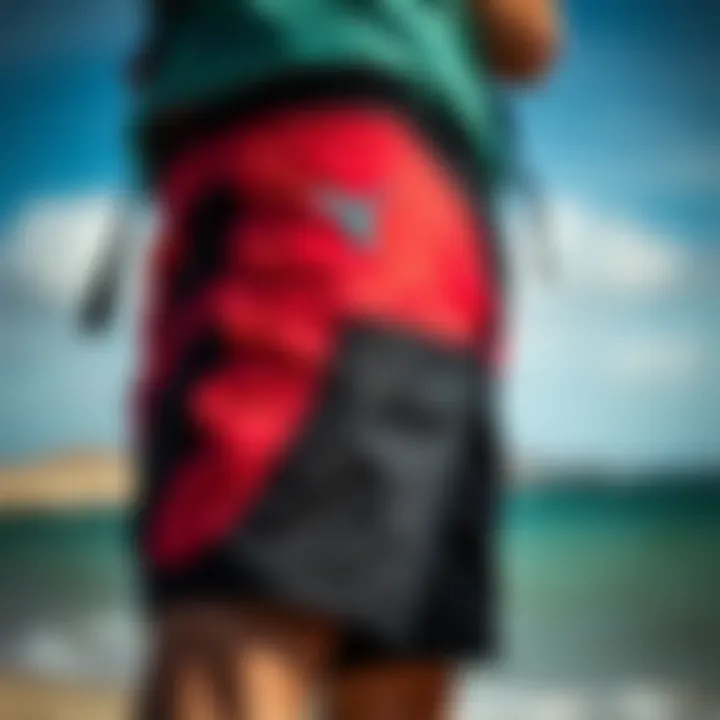Kiteboarding Harness Shorts: Enhance Your Ride


Intro
Kiteboarding harness shorts are more than just a piece of gear; they are central to the kiteboarding experience itself. Designed to combine comfort and functionality, these shorts enhance a rider's mobility and performance on the water. With a surge in popularity over the past few years, it’s crucial for both beginners and veterans of the sport to understand what makes a good pair of harness shorts.
In this exploration, we will unpack the various aspects of kiteboarding harness shorts—from their designs and how they fit into the broader scope of kiteboarding gear, to the innovations shaping the future of this essential item. Harness shorts not only play a role in your comfort while riding, but they also directly influence your performance and safety on the water.
As we dive deeper, expect insights into different styles, essential fitting tips, maintenance practices, and the technological advancements that improve overall functionality. Plus, we’ll touch on the importance of safety considerations, because nothing is more paramount than ensuring a secure ride while chasing that adrenaline rush.
"The right gear can transform your ride from good to great; it's where comfort meets performance."
As we explore the nuances of harness shorts, our goal is to provide knowledge that serves both new enthusiasts and seasoned professionals.
Gear Selection
Types of Harness Shorts
When it comes to selecting the right harness shorts, understanding the different types can make all the difference in your kiteboarding experience. Differentiating between styles is essential, as each type serves a unique purpose.
- Standard Harness Shorts - These are generally designed to be lightweight yet durable. They fit snugly without constricting movement, making them ideal for freeride and freestyle kiteboarding.
- Impact Shorts - Built with additional padding, these shorts offer greater protection against falls and impacts, which is particularly valuable for beginners who may take a tumble more often.
- Full-Body Harness Options - While technically not shorts, some riders prefer these for improved stability and support. They redistribute the load across your body, lessening pressure on your lower back.
Choosing the right type ultimately comes down to your riding style and the conditions you face on the water. The kiteboarding harness shorts should complement your skills while providing enough support and safety.
Choosing the Right Fit
The fit of your harness shorts is critical. A pair that’s too loose can lead to chafing and lack of control, while a tightly fitted one might restrict movement. Here are some tips for achieving that golden fit:
- Measure Yourself: Before heading out for shopping, knowing your waist and hip measurements helps filter down the selection.
- Try Before You Buy: When possible, wear the shorts and perform some stretching movements. Bend, twist, and simulate motions you would do while kiteboarding.
- Consider Your Layering Needs: Some riders prefer to wear thermal gear underneath for colder water conditions. Ensure your shorts accommodate this.
A good fit should feel like a second skin. Lightweight materials that wick away sweat and dry quickly will enhance comfort, so prioritize fabrics that offer breathability alongside flexibility.
Taking time to select the appropriate harness shorts tailored for your needs will surely enhance your overall experience on the water.
Foreword to Kiteboarding Harness Shorts
In the vibrant world of kiteboarding, the right gear plays a pivotal role in a rider's overall experience and performance. Among the many pieces of equipment essential for this adrenaline-fueled sport, harness shorts stand out for their unique design, functionality, and comfort. These shorts not only serve to attach the rider securely to the kite's control system but also provide critical support and protection against the elements.
Harness shorts occupy a crucial space within a kiteboarder’s kit. They allow for freedom of movement while maintaining necessary stability—an essential balance, especially when navigating the unpredictable forces of wind and water. The material used, the fit, and the level of padding are all factors that can significantly impact a rider's agility and comfort level during a session.
Furthermore, harness shorts have evolved over time, reflecting not only advancements in material technology but also changing trends and preferences within the kiteboarding community. In an era where customization and individuality matter, selecting the right pair involves more than just picking the first option off the shelf. Factors like personal riding style, expected water conditions, and even body type come into play, making the selection process all the more critical.
People diving into kiteboarding, as well as seasoned veterans honing their skills, will benefit from understanding the nuances surrounding harness shorts. This article aims to paint a comprehensive picture of harness shorts, delving deep into their basics, their evolution, and the specific features that set different types apart from one another. Equipping oneself with this knowledge not only enhances personal enjoyment of the sport but also fosters a greater awareness of safety and performance measures.
Understanding the Basics
Kiteboarding harness shorts primarily serve one function: connecting the rider to the kite. They offer various types, which can broadly be categorized into waist harness shorts and seat harness shorts. The basic understanding begins with the method of attachment. Riding with a harness creates a direct link from the kite to the body, allowing for a transfer of power that is efficient while maintaining control.
In practice, harness shorts typically feature webbing straps, often with a hook-and-loop fastener to ensure a snug fit. Some may also include additional features such as multiple attachment points, which help to distribute the load while riding. It is therefore important to understand the specifics of the fit and how various designs can affect performance. For instance, waist harness shorts tend to provide a higher degree of mobility, whereas seat harness shorts offer more support and security for the lower back.
The Evolution of Harness Shorts
The history of harness shorts is a reflection of the overall evolution of kiteboarding gear. Originally, kiteboarding relied on more basic designs; however, as the sport grew, so did the need for specialized equipment that offered enhanced functionality. Early versions of harness shorts were often simple and functional, made from rudimentary materials and lacking the design considerations for comfort and performance that modern riders expect.
Recent advancements have led to the introduction of lighter, more breathable fabrics that not only improve comfort but also increase durability. Many contemporary designs incorporate water-repellent finishes, quick-drying capabilities, and even UV protection, catering to the diverse environments where kiteboarding is practiced. In addition, the trend is shifting toward sustainability, with brands exploring eco-friendly materials and practices to resonate with environmentally-conscious riders. This evolution illustrates how, often, the materials and technology behind this gear reflect a broader movement within the sport towards innovation and personal expression.
Types of Kiteboarding Harness Shorts
The choice of kiteboarding harness shorts is crucial for both performance and comfort on the water. Depending on your riding style, body type, and personal preference, selecting the right type can significantly enhance your experience. Knowing the differences between various harness styles is essential as each type serves distinct purposes and comes with unique features. In this section, we will explore three main types of kiteboarding harness shorts: waist harness shorts, seat harness shorts, and hybrid options. Each has its own set of advantages and considerations, providing kiteboarders with tailored solutions to suit their individual needs.
Waist Harness Shorts
Waist harness shorts are perhaps the more commonly used type among kiteboarders. They situate around the waist and usually provide a snug fit that stays in place during intense maneuvers. Generally, they are preferred by riders who value mobility and freedom of movement. The design allows for a natural riding posture, which can be advantageous during jumps and tricks.
Benefits of waist harness shorts include:
- Enhanced Range of Motion: The less restricted body feeling promotes agility during rides.
- Lightweight Design: Often crafted from thinner materials, they can feel breezy and comfortable, especially in warm weather.
- Customization Options: Many have adjustable straps for a snug fit that prevents slipping.


While they do provide several advantages, there are downsides to consider. Some riders may find that they do not offer enough lower back support, especially during long sessions on the water. Therefore, selecting the right padding and fit becomes crucial to avoid discomfort.
Seat Harness Shorts
Unlike their waist counterparts, seat harness shorts sit lower on the hips and wrap around the thighs. This design allows for increased support across the lower back and hips. Seat harness shorts are a popular choice for beginners or riders who may prefer a more stable base while learning the ropes.
Some notable features of seat harness shorts include:
- Additional Support: The design naturally counters the pull of the kite, easing pressure on the lower back.
- Stability for Beginners: They help teach proper stance and balance, making them ideal for those just starting in the sport.
- Safety Factors: The lower positioning helps keep riders grounded, mitigating the chances of being airborne unexpectedly.
However, they can feel bulkier and may limit some movements, which might not appeal to more advanced kiteboarders. As with waist harness shorts, finding the right fit and support level is key.
Hybrid Options
For those who want the best of both worlds, hybrid options are available that merge aspects of both waist and seat harness shorts. These harnesses typically incorporate a waist design with additional leg straps, providing enhanced support without compromising too much on mobility.
Advantages of hybrid options include:
- Versatile Functionality: Excellent for various riding conditions and styles, they cater to both leisure and performance.
- Balance Between Freedom and Support: Riders can benefit from the flexibility associated with waist harnesses while enjoying the added security found in seat designs.
- Customization of Fit: Many hybrids come equipped with multiple adjustment points for a tailored fit based on preferences and body type.
Choosing the right type of harness short ultimately comes down to your personal needs, riding style, and comfort level. Whether preferring the agile feel of a waist harness or the stability of a seat harness, understanding these types is essential for optimizing your kiteboarding adventures.
Key Features of Harness Shorts
When selecting kiteboarding harness shorts, understanding their key features can greatly influence both comfort and performance on the water. These design elements play an essential role not only in functionality but also in enhancing a rider's overall experience. Without paying attention to these aspects, a kiteboarder may find themselves constantly adjusting or, worse, battling discomfort during their ride. Let's dive into these features for a deeper comprehension.
Material Composition
The fabric used in harness shorts is not just a trivial decision; it’s fundamental for durability, flexibility, and comfort. Look for materials like neoprene, which provides excellent elasticity and insulation. Additionally, some harness shorts incorporate high-tenacity nylon, notable for its strength and abrasion resistance.
A common choice among riders is a combination of both materials, allowing for a balance of comfort and resilience. It’s also worth mentioning the rise of eco-friendly fabrics which have made their way into the market. These sustainable materials often offer similar performance benefits without compromising on environmental integrity.
Another essential aspect here is the water-resistance of the fabric. The quicker it dries, the less weight you will carry during your session, and the more comfortable the experience will be.
"Choosing the right material can mean the difference between a stellar ride and an uncomfortable nuisance."
Padding and Support
Padding is another critical feature that should not be overlooked. The presence of padding around the lower back and hips can make a huge difference in how you feel after hours of kiteboarding. It acts as a buffer against impact and reduces the strain on sensitive areas. Some designs even consider added protection against falls or rough landings, much like the protective gear used in other extreme sports.
When considering padding, one should also think about its weight and firmness. Too much padding can hinder movement, while too little may not provide adequate support. An optimal level of cushioning can greatly assist in maintaining posture and ensuring that a rider remains stable, especially during harsher conditions.
Adjustability and Fit
Adjustability is where versatility shines in harness shorts. Most shorts come equipped with adjustable straps designed to provide a snug and tailored fit, accommodating variations in body shape and size. This feature is vital for ensuring that the harness stays in the right position during rides and does not shift unexpectedly. Furthermore, many harness shorts now incorporate innovative clip systems or Velcro combinations that simplify adjustments while still allowing a solid hold.
Fit is also a crucial factor. A well-fitted harness short can enhance performance by preventing any unnecessary movement that could distract or hinder the kiteboarding experience. When purchasing, consider trying different sizes or styles to find what aligns best with your body type and riding style. A bad fit not only affects comfort but can have larger implications on your overall safety when maneuvering through challenging water conditions.
In essence, selecting the right harness shorts is about harmonizing these key features—material, padding, and adjustability. Each element is intertwined with performance and comfort in mind, shaping how effectively you can engage with the waves and harness the wind.
Choosing the Right Harness Shorts
Selecting the right kiteboarding harness shorts goes beyond just the aesthetics; it's a decision that directly impacts your performance on the water. The fit, style, and overall functionality of the harness shorts you choose can significantly enhance your every ride. It’s like finding the perfect pair of shoes—one that feels just right allows you to focus on the thrill of kiteboarding rather than adjusting your gear. In this section, we will explore key considerations that will help you navigate this decision-making process.
Sizing Considerations
Getting the size right is akin to hitting the target bullseye. It’s essential to ensure you have the correct fit for optimal comfort and performance. Sizes can differ between brands, which can make choosing the right one tricky. If you're on the border between two sizes, it’s usually advisable to err on the side of the larger option.
When you’re sizing harness shorts:
- Measure Your Waist: Use a soft measuring tape to gauge the circumference of your waist. This will give you a baseline for your size.
- Layering Considerations: If you plan to wear a wetsuit underneath, take that into account. You might need to choose a size larger to accommodate the extra bulk.
- Try Before You Buy: If possible, wear them and do some movements simulating kiteboarding. Stretch, bend, and twist to see if they allow for mobility without feeling too loose or restrictive.
Finding the right fit can make a world of difference, keeping your focus on mastering your skills rather than adjusting your shorts every few minutes.
Style Preferences
Style preference might seem superficial at first glance, but they can greatly affect both performance and enjoyment. There are a few points to consider:


- Colors and Patterns: Bold colors can help with visibility on the water, especially if you are riding in busy places. Patterns can also reflect your personality—some riders prefer sleek, minimalist designs, while others enjoy showing off something bright and loud.
- Cut and Design: The way the shorts are cut significantly impacts your aerodynamics. Opt for designs that minimize drag. Additionally, some riders might prefer shorts that resemble swim trunks for better water flow, while others lean toward more structured designs.
- Functional Features: Pockets, D-rings, or straps can be beneficial. Pockets are useful for storing small items you may want at hand, while attachment points for accessories can simplify your setup process.
Take your time to determine what looks good and fits your riding style. After all, kiteboarding is not only about agility on the water—it's also about feeling confident in your gear.
Rider Skill Level and Needs
The choice of harness shorts should align with your skill level and what you intend to achieve while kiteboarding. A beginner will have different needs compared to a seasoned kiter. Here’s a rundown:
- Beginners: Those just starting out might prioritize comfort and ease of use. Look for harness shorts that provide good support without overwhelming features that might complicate the experience.
- Intermediate Riders: At this stage, you should consider more specialized shorts that may aid in specific techniques or maneuvers. Durability becomes crucial, as you're likely pushing your limits more frequently.
- Advanced Riders: For seasoned kiteboarders, the focus might shift toward performance-enhancing features. This is where cutting-edge materials and designs might come into play. Look for options that allow maximum energy transfer and greater control.
"Choosing the right gear makes the difference between joy and frustration. Don’t skimp on what you wear."
Overall, selecting the right shorts may sound daunting due to the variations available, but aligning your choice with your proficiency and needs will maximize your kiteboarding experience. Whether you’re riding the waves for leisure or sport, the right harness shorts will ensure that your time on the water is as enjoyable and productive as possible.
Performance Enhancements
When it comes to kiteboarding, the right gear can make or break a session on the water, and harness shorts are no exception. The significance of performance enhancements in kiteboarding harness shorts is twofold: they directly impact your riding style and dictate how effectively energy transfers between you and your kite. By understanding these enhancements, kiteboarders can fine-tune their approach, leading to better rides and enhanced control.
Impact on Riding Style
The design of harness shorts plays a pivotal role in determining a rider’s style on the water. For instance, the fit and style of the shorts often dictate how a rider maneuvers. A snug fitting waist harness short can give a more streamlined feel, enabling better aerial tricks, while roomier seat harness shorts may allow for more relaxed riding but can hinder agility.
Consider this: you wouldn’t wear wide-legged trousers for a sprint, right? Harness shorts are no different. They need to align with your individual style and needs. If you’re all about fluid transitions and dynamic moves, opting for a more fitted shorts might just be the key to achieving that flowing riding technique.
- Enhanced Flexibility: Shorts that allow more motion and flexibility can lead to improved performance. When you can move without restriction, tricks become easier to execute.
- Core Engagement: Good harness shorts help engage your core better, allowing for precise control during rotations or jumps. The more connected you feel to your kite through your harness, the better your overall technique becomes.
A well-fitted harness short isn’t just a piece of gear; it’s an extension of your body, enhancing your performance, and empowering your choices on the water.
Energy Transfer and Control
The efficiency of energy transfer is key in kiteboarding, particularly when it comes to navigating gusts and maintaining speed. Your harness shorts are central in this process. Think about how a well-made harness can become your best ally in maximizing energy from the kite to your body.
- Direct Connection: Harness shorts enable a direct energy route from your kite through to your core. If the shorts fit properly and provide the right support, you’ll feel the kite's pull translated into your movements more effectively. This connection is crucial for maintaining speed and control when executing quick turns or jumps.
- Reduced Fatigue: When energy transfers smoothly, the rider experiences less fatigue. It means your body doesn’t have to work overtime to stay in sync with the kite, allowing for longer sessions with improved endurance.
- Adjustability Features: Some harness shorts come with features designed to enhance energy transfer, such as adjustable straps. Riders can fine-tune the fit to suit their specific style while maximizing energy efficiency.
In summary, understanding how the right pair of harness shorts can influence your riding style and energy transfer is essential. Properly designed and fitted shorts can offer enhanced performance, control, and overall enjoyment while kiteboarding.
Maintenance and Care for Harness Shorts
Caring for kiteboarding harness shorts extends their lifespan and ensures optimal performance on the water. Just like any essential gear, proper maintenance can make all the difference in comfort and durability. Whether you are a newcomer to the kiteboarding scene or a seasoned pro, the way you maintain your harness shorts can significantly impact your riding experience. Let's break down two critical aspects of upkeep: washing guidelines and storage recommendations.
Washing Guidelines
Keeping your harness shorts clean is paramount. After all, they face exposure to sand, saltwater, and various elements that can degrade the material. Here are some key points to consider when washing your shorts:
- Rinse immediately: As soon as you finish your session, give the shorts a quick rinse in fresh water. This helps to remove salt and sand, preventing build-up that can damage the fabric over time.
- Use a gentle detergent: When it comes time for a more thorough clean, opt for a mild detergent. Regular laundry detergents can be harsh and may strip the colors or weaken the fabric.
- Cold water wash: Always wash in cold water to help retain the elasticity and shape of the shorts. Hot water can warp the padding and materials, leading to discomfort during your rides.
- Avoid fabric softeners: While they may leave a pleasant scent, fabric softeners can cling to the technical fibers of your shorts, reducing their effectiveness and breathability.
- Air dry: Instead of tossing your harness shorts in the dryer, let them air dry. Lay them flat or hang them up to encourage even drying, which helps maintain their structural integrity. Sun drying, however, should be approached with caution as prolonged exposure to UV rays can cause fading.
"A little TLC goes a long way—proper care of your harness shorts boosts performance and longevity!"
Storage Recommendations
Storing your kiteboarding harness shorts correctly is just as important as washing them. Improper storage can lead to creases, breakdown, or even unwanted odors. Here are some effective storage tips:
- Dry completely: Before putting your shorts away, make sure they are thoroughly dry to prevent mildew or mold growth, especially if they are stored in a damp environment.
- Avoid folding creases: Rather than folding, try rolling your shorts to prevent creasing where the fabric bends. This helps maintain their shape and protective padding.
- Keep in a cool, dark place: Store your shorts in a dry area away from direct sunlight. This not only preserves colors but also protects them from excessive heat that could warp the materials.
- Use breathable bags: If you prefer to keep them in bags, opt for breathable storage solutions. Plastic bags trap moisture, intensifying the risk of odor and mildew.
Following these maintenance and care steps can ensure that your kiteboarding harness shorts remain in top-notch condition. Remember, investing time in proper care can enhance your comfort and performance on the water, providing a smoother, more enjoyable ride.
Safety Considerations
The essence of safe kiteboarding cannot be overstated, especially regarding the gear that supports every rider's movement and stability on the water. Kiteboarding harness shorts play a pivotal role, acting as a critical connection between the rider and the kite's power. Understanding the safety aspects related to these shorts ensures that riders can focus on enjoying their time on the water without unnecessary risks. Below, we explore two critical elements of safety that each kiteboarder should keep in mind when selecting and using harness shorts.
Preventing Injuries
The risk of injuries in kiteboarding is present, as with any extreme sport. The right harness shorts can help to minimize this risk significantly. These garments are designed to offer support, protection, and comfort in various conditions. Here are several factors to consider in injury prevention:
- Proper Fit: Harness shorts that fit well are crucial. If they are too loose, they can shift during maneuvers, causing chafing or discomfort, which can lead to distractions and potential incidents. On the other hand, if they’re too tight, they may restrict movement, impairing balance and control.
- Padded Protection: Many harness shorts come equipped with extra padding around the hips and thighs. This feature is beneficial for reducing impact during falls or collisions with water. Discomfort can easily lead to a fall if a rider is not fully engaged with their board.
- Adjustable Straps: Harness shorts often have adjustable elements that allow the rider to fine-tune the fit around their waist or legs. This adaptability is not just there for comfort but acts as a safety measure by ensuring the gear stays securely in place.
- Reinforced Areas: Look for shorts with reinforced seams and tougher fabrics in high-wear areas. These design choices can prolong the lifespan of your gear and prevent wear that could lead to unexpected breakage.
"A well-fitted harness short is an extension of your body; it enables you to navigate the waves while protecting your vital areas from injury."


Weather and Water Conditions
Weather and water conditions play a significant role in kiteboarding safety. Here’s how the choice of harness shorts can influence rider safety in varying conditions:
- Temperature Adjustments: In colder climates, opt for thicker, insulated materials that can help retain warmth while providing necessary protection against the elements. This is essential, as exposure to cold water can lead to hypothermia during extended sessions.
- Hydrodynamic Design: The sleek, streamlined design of some harness shorts prevents drag, allowing for better performance in choppy waters. Avoiding resistance can enhance control, reducing the chances of losing balance and falling.
- Visibility Factors: When conditions are murky or visibility is low due to weather changes, opting for brightly colored shorts can make it easier for instructors or fellow riders to spot you, improving safety through increased awareness on the water.
- Quick-Drying Materials: Shorts made from quick-drying fabrics not only enhance comfort but also maintain buoyancy. This is an important factor if a rider takes a spill, as wet clothing can weigh a person down, leading to exhaust and potential safety risks.
Current Trends in Kiteboarding Harness Shorts
In the ever-evolving world of kiteboarding, harness shorts have not remained untouched by innovation. The latest trends indicate a shift towards designs that not only enhance performance but also appeal to the growing demands of sustainability and technology. Understanding these trends is vital for both riders looking to upgrade their gear and manufacturers aiming to meet the needs of modern kiteboarders.
Sustainable Materials
Sustainability in kiteboarding is more than just a buzzword; it's becoming a reality as the industry seeks to lessen its environmental footprint. Harness shorts crafted from recycled materials, such as repurposed PET bottles or organic cotton, are gaining traction. These materials not only reduce waste but also offer riders durable products without sacrificing performance.
- Benefits of Sustainable Materials:
- Reduces plastic waste from landfills and oceans,
- Provides high-quality fabrics that perform well in water,
- Potential for companies to attract eco-conscious consumers,
- Often use dyes and treatments that are less harmful to the environment.
Riders are more aware than ever of the products they use. They want to take the waves while making choices that do not harm the planet. Brands are responding by integrating eco-friendly practices into their production processes. This shift not only addresses consumer demand but also promotes an industry culture that values responsibility over fast fashion.
"It's not just about riding the wind anymore; it's also about riding the wave of sustainability."
Technological Advancements
On the tech side, recent advancements are transforming the way kiteboarding harness shorts are designed and perceived. Incorporating features such as moisture-wicking fabrics and adjustable straps creates a more comfortable and tailored experience for the rider.
- Key Technological Features:
- Moisture-Wicking Fabrics: Helps in keeping the skin dry and comfortable, especially during extended sessions on the water.
- Smart Materials: Some brands are experimenting with fabrics that adjust to body temperature or fit, ensuring optimal performance across different weather conditions.
- Integrated Safety Features: New designs are coming with built-in impact protection and reflective strips for visibility, enhancing safety for riders.
The integration of technology doesn't stop at fabric innovations; it extends to how riders interact with their gear. With the advent of mobile applications that track performance metrics, some shorts are designed to work in conjunction with these platforms, giving riders feedback that can be used for improving their skills.
Both the sustainable and technological advancements reflect the changing landscape of the sport, catering to an audience that is as conscious about their gear's impact as they are about performance on the water. As kiteboarding continues to mature, so too will the equipment that facilitates its growth.
Community Insights and Reviews
In the evolving world of kiteboarding, harness shorts are not just pieces of gear; they are a reflection of experiences shared within the community. Understanding community insights and reviews unfolds a rich tapestry of feedback that can lead to more informed choices for kiteboarders, whether they are seasoned riders or newcomers to the sport. This section dives into the lived experiences of riders and the expert opinions from instructors, providing a holistic view of what makes harness shorts a vital part of kiteboarding.
Rider Experiences
Riders often become the best critics of their gear because they put it to the test under real conditions. Feedback from the kiteboarding community reveals not only personal anecdotes but also practical insights. Riders commonly share their favorites through various platforms, like Reddit or specialized forums. The discussions frequently broadcast a wide range of experiences:
- Comfort and Fit: Riders often emphasize how certain brands or styles either enhance or hinder their performance. Many report that harness shorts with adjustable components allow for a more personalized fit, contributing to longer, more enjoyable sessions on the water.
- Material Performance: Adjustments in the design or material composition can lead to different outcomes in water sport scenarios. Users frequently note experiences about how well their shorts keep up with the physical demands, especially in choppy water or strong winds.
- Recommendations: Word of mouth carries weight. When riders find a product that they feel boosts their performance, they tend to recommend it to peers. Personal stories often guide new kiteboarders to products that have been road tested rather than simply selecting based on marketing claims.
These shared experiences are critical as they not only assist in decision-making but also create a sense of belonging within the sport. When riders engage in conversations about gear, they’re helping to foster community wisdom.
Instructor Opinions
Instructor insights add another layer of depth to community reviews. Instructors possess a professional vantage point, having taught numerous students and seen various gear in action. Their feedback is usually more analytical and focused on performance indicators:
- Safety Features: Instructors often highlight the importance of safety precautions. They can pinpoint which harness shorts provide adequate support and prevent injuries based on years of teaching. Safety is paramount, and the right gear can make a significant difference in ensuring riders stay safe while learning.
- Training Suitability: Many instructors specify the types of harness shorts that work best for specific skill levels. Beginners may benefit from extra padding, while advanced riders might prioritize freedom of movement over additional support. Insight into how equipment adapts to a rider's progression can prove invaluable.
- Durability Over Time: Given that instructors observe their students’ gear choices over several seasons, their opinions on durability carry weight. They often identify specific brands that withstand the rigors of repeated use, urging students towards those that withstand wear and tear effectively.
"What works best often comes down to personal preference influenced by experience and the unique conditions experienced on the water." - Anonymous Instructor
For further insights and discussions, consider visiting communities on platforms such as Reddit or links to articles on Wikipedia about the sport.
Closure
As we wrap up our deep dive into kiteboarding harness shorts, it's essential to underscore their critical role in both enhancing safety and elevating performance on the water. These specialized garments are not merely accessories; they represent a fusion of functionality, comfort, and technology, tailored to meet the needs of a diverse group of riders—from novices to seasoned enthusiasts.
Final Thoughts
Effective kiteboarding harness shorts provide a solid foundation for an enjoyable and safe ride. Riders equipped with the right pair benefit from features like optimal padding, snug fit, and durable materials that can withstand the rigors of the ocean. It's evident that the right choice in harness shorts can significantly impact a rider’s experience, allowing for better energy transfer and ultimately improving overall performance.
The experiences of fellow riders jointly illustrate the profound effect that these harness shorts have. Many have shared that it’s not just about protection; it’s about the freedom they feel to express their skills and push their limits. Whether gliding over the waves or engaging in aerial maneuvers, harness shorts seem to boost both confidence and creativity.
Looking Ahead
Looking into the future, the development of kiteboarding harness shorts appears promising. As technology continues to evolve, expect to see greater inclusivity in design, allowing for a variety of body shapes and sizes, and incorporating sustainable practices that appeal to conscientious riders.
Moreover, advancements in materials engineering could lead to even lighter and more breathable options, enabling kiteboarders to maximize their time in the elements without the usual discomfort. Engaging with community insights and paying attention to trends will be key as we embrace these innovations.
In summary, kiteboarding harness shorts not only serve as crucial gear but also symbolize the spirit of the sport—dynamic, innovative, and ever-evolving. As the kiteboarding community continues to expand, so will the dialogue around how harness shorts can improve experiences on the water. Harnessing the wind is exhilarating; with the right gear, including well-crafted harness shorts, it can be all the more thrilling.















